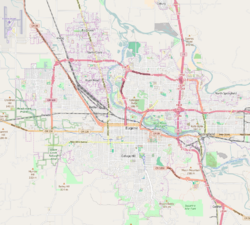The Oregon Museum of Science and Industry is a science and technology museum in Portland, Oregon, United States. It contains three auditoriums, including a large-screen theatre, planetarium, and exhibition halls with a variety of hands-on permanent exhibits focused on natural sciences, industry, and technology. Transient exhibits span a wider range of disciplines.
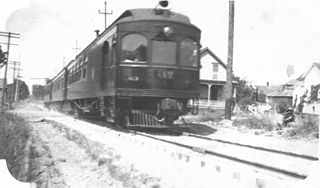
The Oregon Electric Railway (OE) was an interurban railroad line in the U.S. state of Oregon that linked Portland to Eugene.

Dearborn Station was, beginning in the late 1800s, one of six intercity train stations serving downtown Chicago, Illinois. It remained in operation until May 1, 1971. Built in 1883, it is located at Dearborn and Polk Streets, to the south of the Loop, adjacent to Printers Row. The station was owned by the Chicago & Western Indiana Railroad, which itself was owned by the companies operating over its line. The station building headhouse now houses office, retail, and entertainment spaces, and its trackage yard, behind the headhouse, was redeveloped into part of the Dearborn Park neighborhood.

Portland Union Station is a train station in Portland, Oregon, United States, situated near the western shore of the Willamette River in Old Town Chinatown. It serves as an intermediate stop for Amtrak's Cascades and Coast Starlight routes and, along with King Street Station in Seattle, is one of two western termini of the Empire Builder. The station is a major transport hub for the Portland metropolitan area with connections to MAX Light Rail, the Portland Streetcar, and local and intercity bus services. The station building contains Wilf's Restaurant & Bar on the ground level and offices on the upper floors. It also has Amtrak's first Metropolitan Lounge on the West Coast, which is reserved for first-class sleeping car and business-class passengers.
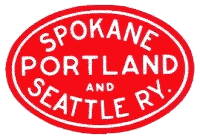
The Spokane, Portland & Seattle Railway was a railroad in the northwest United States. Incorporated in 1905, it was a joint venture by the Great Northern Railway and the Northern Pacific Railway to build a railroad along the north bank of the Columbia River. The railroad later built or acquired other routes in Oregon. The SP&S was merged into the Burlington Northern in March, 1970. Remnants of the line are currently operated by BNSF Railway and the Portland and Western Railroad.

The Chattanooga Choo-Choo in Chattanooga, Tennessee, is a former railroad station once owned and operated by the Southern Railway. Listed on the National Register of Historic Places, the station operated as a hotel from 1973 to 2023, and was a member of Historic Hotels of America, part of the National Trust for Historic Preservation. The two-floor hotel building, once called The MacArthur building, was renovated and renamed in 2023 to The Hotel Chalet by Trestle Studio, a Chicago-based development group.

Spaghetti Warehouse is an Italian restaurant chain geared towards families with five physical locations in two U.S. states: four in Ohio, one in New York (state). They also operate a to-go only location in Texas. The chain started in 1972 in Dallas, Texas, and at one point had spread throughout the southern and eastern parts of the United States. Each restaurant has a trolley car in the dining room and patrons are able to sit in the car. One of Spaghetti Warehouse's unique characteristics is that many of the older locations are in renovated, historic buildings.
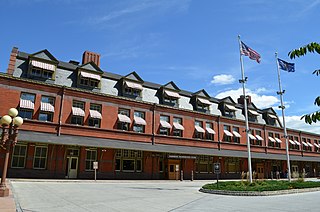
The Harrisburg Transportation Center is a railway station and transportation hub in Harrisburg, Pennsylvania. It is located on the eastern edge of Downtown Harrisburg between the intersections of Aberdeen and Market Streets and 4th and Chestnut Streets.

Powerland Heritage Park, formerly known as Antique Powerland, is a collection of museums and a self-described heritage site for power equipment, such as farm machinery, commercial trucks, trains, trolleys, construction equipment, logging equipment, and the engines which power them. It is located in Brooks, Oregon, United States, and is operated by the non-profit Antique Powerland Museum Association (APMA). It was initially established by a group of enthusiasts "dedicated to the preservation, restoration and demonstration of steam powered equipment, antique farm machinery and implements."

The Fullerton Transportation Center is a passenger rail and bus station located in Fullerton, California, United States.

Samtrak was a heritage railroad that operated in Oregon from 1993 to 2001.

Eugene station is a train station in Eugene, Oregon, United States. It is served by Amtrak's Coast Starlight passenger train and is the southern terminus of the Amtrak Cascades corridor. The station is also served by the Cascades POINT bus service.

The Canaan Union Depot, also known as the Union Depot, is located in Canaan Village, in the town of North Canaan, Connecticut, and is a former union station. It was built in 1872 at the junction of the Housatonic Railroad and the Connecticut Western Railroad which was acquired by the Central New England Railway.

The Eugene Science Center, located in Alton Baker Park in Eugene, Oregon, United States, is a science and technology center for children, families, and school groups. The 10,000-square-foot (930 m2) museum near Autzen Stadium features changing interactive exhibits, planetarium shows, camp programs, special events and other science and technology-related education programs. Eugene Science Center is an independent 501(c)(3) non-profit organization governed by a volunteer board of directors. Its mission is: "To engage children, excite their curiosity, inspire them toward a lifetime love of science, and empower them to use science and technology to improve their communities." Eugene Science Center is the only science museum in Lane County and surrounding counties.
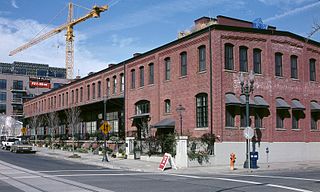
The North Bank Depot Buildings, in central Portland, Oregon, United States, are a pair of buildings formerly used as a freight warehouse and passenger terminal for the Spokane, Portland and Seattle Railway (SP&S). Formed in 1905, the SP&S was commonly known as the North Bank Road during the period in which these buildings were in use. The Portland buildings' passenger facilities were also used by the Oregon Electric Railway after that railway was acquired by the SP&S. Located in what is now known as the Pearl District, the buildings were listed on the National Register of Historic Places in 1996. They were in use by the SP&S and its successor, Burlington Northern Railroad, from 1908 until the 1980s. Only the east building was used as a passenger station, and this usage lasted from 1908 until 1931.

The Hood River station is a historic train station in Hood River, Oregon, currently serving the heritage Mount Hood Railroad. The station was listed on the National Register of Historic Places in 1988 as the Oregon–Washington Railroad and Navigation Company Passenger Station. The station was built by the Oregon–Washington Railroad and Navigation Company, a subsidiary of the Union Pacific Railroad, in 1911. Amtrak's Pioneer also used the station and nearby area from 1977 to 1997.

The Portland General Electric Company Station "L" Group in southeast Portland in the U.S. state of Oregon was a cluster of six industrial buildings listed on the National Register of Historic Places. Built between 1910 and 1929 by Portland General Electric (PGE), it was added to the register in 1985. In 1986, PGE gave Station L and 18.5 acres (7.5 ha) of land to the Oregon Museum of Science and Industry (OMSI). The Station L turbine is a central feature of OMSI's Turbine Hall. The complex was listed on the National Register in 1985, and was delisted in 2020.
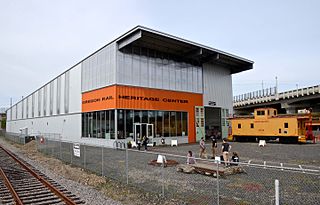
The Oregon Rail Heritage Center (ORHC) is a railway museum in Portland, Oregon. Along with other rolling stock, the museum houses three steam locomotives owned by the City of Portland: Southern Pacific 4449, Spokane, Portland & Seattle 700, and Oregon Railroad & Navigation Co. 197, the first two of which are restored and operable. The center opened to the public on September 22, 2012. The project to establish the center was led by the Oregon Rail Heritage Foundation (ORHF), a non-profit organization, which was renamed from the Oregon Heritage Steam Foundation in 2002. The non-profit Oregon Steam Heritage Foundation was formed in 2000. The museum site is in Southeast Portland.

Redlands–Downtown station is a rail station serving downtown Redlands, California, United States. The station was built in 1910 for the Atchison, Topeka and Santa Fe Railway and operated until 1938. The facility was preserved and reopened on October 24, 2022 as part of the Arrow commuter rail service.
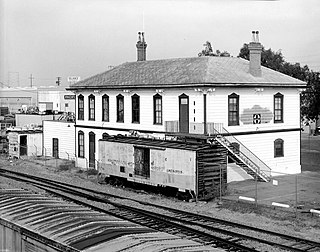
National City station is a former railway station in National City, California. The California Southern Railroad, a subsidiary of the Atchison, Topeka and Santa Fe Railway, chose National City as the West Coast base of operations at the terminus of their planned transcontinental railroad.

